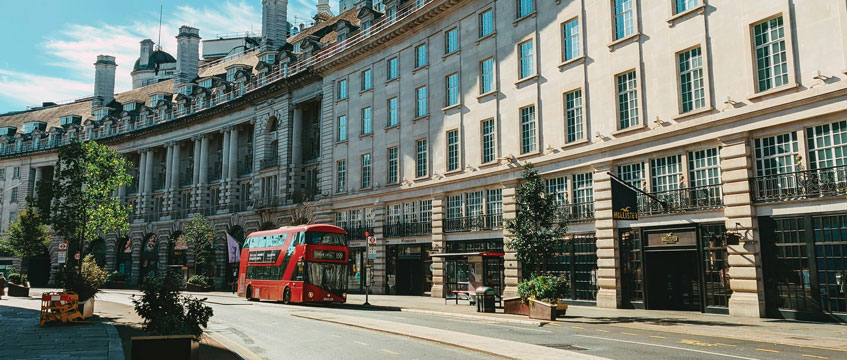Westminster risks ‘catastrophic decline’ in office space
Westminster has lost almost 4m sq ft of office space since 2019, with the Westminster Property Association warning that a more balanced approach to planning is needed to help avoid a “catastrophic decline” in employment space.
In a new report published with Arup, the WPA said a fresh attitude to planning could unlock 14m sq ft of new commercial floorspace and 87,000 jobs between now and 2045.
Major planning applications in the borough have fallen by more than 80% since 2016, according to the report, Delivering Good Growth in Westminster . The WPA has warned that without a sustained effort to reverse this trend, the West End’s position as a key business district in the capital will be threatened and tax revenue lost. Westminster’s Central Activities Zone contributes 14% of London’s economic output and 13% of jobs, the WPA said, but has experienced a 3.7m sq ft loss of office floorspace since 2019, despite the opening of the Elizabeth Line and continued demand for modern workspace.
Westminster has lost almost 4m sq ft of office space since 2019, with the Westminster Property Association warning that a more balanced approach to planning is needed to help avoid a “catastrophic decline” in employment space.
In a new report published with Arup, the WPA said a fresh attitude to planning could unlock 14m sq ft of new commercial floorspace and 87,000 jobs between now and 2045.
Major planning applications in the borough have fallen by more than 80% since 2016, according to the report, Delivering Good Growth in Westminster. The WPA has warned that without a sustained effort to reverse this trend, the West End’s position as a key business district in the capital will be threatened and tax revenue lost. Westminster’s Central Activities Zone contributes 14% of London’s economic output and 13% of jobs, the WPA said, but has experienced a 3.7m sq ft loss of office floorspace since 2019, despite the opening of the Elizabeth Line and continued demand for modern workspace.
The report noted that some London boroughs have increased their volume of office space as Westminster’s has shrunk, including Southwark and Camden, which have posted 9% growth since 2019, compared with a 6% drop in Westminster. “There is a possibility that these boroughs have capitalised from the contraction of Westminster CAZ’s office market,” it added.
Marcus Geddes, WPA chair and managing director for workplace at Landsec, said: “Westminster is a key economic engine of London and the UK. This study lays bare the huge impact planning policy can have on social and economic prosperity. A more balanced approach that weighs heritage, environmental and economic factors has the potential to unlock significant benefits. Good growth has the capacity to provide much-needed funding for public sector services and infrastructure by creating sustainable workspaces that will attract leading employers.”
The study outlined three scenarios for economic growth over the next two decades, each with a different approach to planning policy, sustainability and conservation.
Under a best-case “balanced growth” scenario, in which planning policy encourages retrofit and sustainable redevelopment, an additional 14m sq ft of commercial space could be delivered, including 7.7m sq ft of office space, 2.5m sq ft of retail space and 2.4m sq ft of hotel accommodation, alongside 9,300 homes. Under a “business as usual” scenario, 7.2m sq ft of floorspace could be delivered, and under a “checks on growth” scenario, with policy weighted towards conservation, there could be a 6.3m sq ft decline in commercial floorspace, including a loss of 8.3m sq ft of office space.
“The worst-case scenario, in which policy is weighted more heavily towards conservation, could see a catastrophic decline in employment space that would threaten the West End’s status as a leading global business district,” Geddes said. (See section below for more details on the scenarios.)
Philip Hobley, head of London offices at Knight Frank and a WPA board member, added: “The erosion of the property industry’s ability to provide best-in-class, sustainable workplaces which companies demand is a worrying trend. A continuation of this severe constraint on supply in the worst-case scenario matters not just to Westminster, but to London and the UK as a whole.”
However, despite the warnings over reduced office space, the report noted that the “checks on growth” scenario is “not without merit”.
“Historic assets would be preserved and, over time, the quality of the built environment would exceed the other scenarios,” the report said. “It delivers only slightly lower levels of housing, albeit with fewer jobs, and lower GVA. The jobs that would be created are more likely to be in face-to-face industries as the Westminster CAZ becomes less of a place for Londoners to work and instead attracts a larger proportion of visitors and residents. These are sectors that have traditionally employed people with fewer qualifications.”
It continued: “At the moment, Westminster CAZ manages a subtle balance of the interests of workers, visitors and residents. This difficult balancing act needs to continue in the era of retrofit, environmentally friendly building uses, demand for high-quality office space, and more experiential retail and leisure. The recent case of Marks & Spencer’s Marble Arch store on Oxford Street has demonstrated the wide range of interests that decision-makers are required to take into account.”
The report recommended “consideration of a balanced growth-orientated approach in the Westminster CAZ”, including “a flexible approach to allow developers to both meet legitimate commercial requirements whilst fulfilling environmental objectives”.
“Implementation of this will require a pragmatic approach and joint working across Westminster City Council, the GLA, business improvement districts, investors, the construction industry and neighbourhood forums,” the report concluded. “It is important that the case for economic growth in the Westminster CAZ is understood in and supported by mayoral and central government due to its major economic role for London and the UK, as well as the essential national and international functions hosted in the area.”
Three scenarios for Westminster’s economic growth
Business as usual: no major change in planning approach
This would lead to only a marginal increase in jobs, economic output and taxes generated by 2045, with a 7% growth in floorspace. That additional floorspace could accommodate 41,000 new jobs. There would be a modest increase in revenue linked with real estate development, and around 7,300 homes would be delivered in the Westminster CAZ through conversions and new developments.
Balanced growth: flexible and balanced approach to retrofit and redevelopment
More flexible planning policies would lead to higher levels of job creation and housing delivery. Under this scenario, Westminster would see 14% floorspace growth, or some 8m sq ft of new office space. More office workers would boost accommodation, culture and creative industries, and tourism would be more likely to be sustained. The number of new homes would be in line with the council’s target of 20,685 across the borough by 2040.
Checks on growth: policy weighted heavily towards conservation
This approach, with an emphasis on conservation and conversion, would see less new commercial space delivered and a decline in higher-value office jobs, but would make the area more appealing to visitors and residents. Although historical assets would be preserved, the challenges of redeveloping existing offices into grade-A space would result in a 6% reduction of commercial space by 2045.
Image © Thomas Konings/Unsplash











